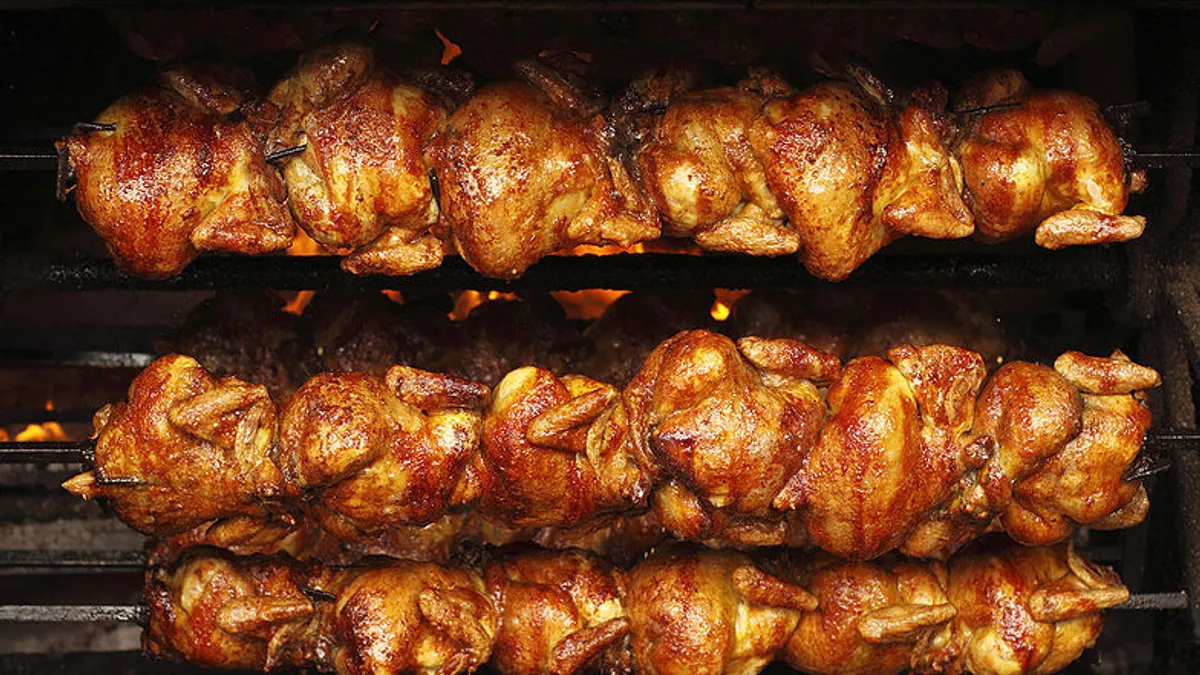Dive Brief:
-
Rotisserie chickens are still a big draw for grocery stores that sell them, according to The Wall Street Journal. U.S. consumers bought 625 million of the spit-roasted birds at supermarkets last year.
-
But in order to sell rotisserie chickens for $5 to $7 each — a common price range — retailers have to keep supply chain costs low, roast chickens more efficiently and not waste them, the Journal noted. For these efforts, grocers are rewarded when shoppers stick around to buy other, higher-margin food and beverage products while they're in the store.
-
"If they get a chicken, a salad, and maybe they pick up a bottle of wine — now we’re really talking,” Don Fitzgerald, vice president of merchandising at Mariano’s, a Kroger-owned Chicago grocery chain, told the newspaper.
Dive Insight:
Rotisserie chickens were first introduced in U.S. grocery stores in the early 1990s, and they’re still going strong today. Most major supermarkets offer them, including Kroger and Costco, often as "loss leaders," which is the strategy of selling a product at below market cost to stimulate sales of other, more profitable, goods and services.
Costco leans heavily on rotisserie chicken, which it sells for $4.99 each, and sold about 87 million of them last year compared to about 60 million in 2013, Time magazine reported. In fact, the company announced this past June that it was building its first poultry processing plant and hatchery in Nebraska to supply two million more chickens per week for sale in Costco stores.
Costco's low price hasn't budged since 2009, and the club retailer has acknowledged the hit to its bottom line. "I can only tell you what history has shown us: When others were raising their chicken prices from $4.99 to $5.99, we were willing to eat, if you will, $30 to $40 million a year in gross margin by keeping it at $4.99. That’s what we do for a living," Costco's chief financial officer, Richard Galanti, told The Seattle Times in 2015.
Whole Foods used to charge $8.99 for a rotisserie chicken, but since the company was acquired by Amazon last year, the price is now $8 for the classic, antibiotic-free option and $10 for an organic chicken. Whole Foods also offers lemon-herb and spicy buffalo versions of the popular item.
A Whole Foods spokesperson recently told Popsugar that the company follows animal welfare standards in sourcing: "Like the chicken found in our fresh meat case, all our rotisserie chickens come from farms certified by the Global Animal Partnership (GAP) 5-Step animal welfare rating system. They also meet our high quality standards — no antibiotics, no added growth hormones, and no animal byproducts in feed."
Rotisserie chickens are an easy, tasty and cheap way to grab dinner, along with a side dish or two, on the way home from work without going to the trouble of buying more expensive raw chicken and taking the time and energy to cook it yourself. Customers note that when the pre-cooked chickens are placed near the checkout stands, the smell is sometimes enough to prompt a last-minute purchase.
Grocers are changing up their rotisserie chicken items by trying different flavors, such as barbecue or lemon pepper, plus adding organic and antibiotic-free chickens to the mix to appeal to a broader range of customers, the Journal reported. Helpful retailers might go a step beyond signage and tell customers how to easily and most efficiently cut up a rotisserie chicken, and how to use the leftovers to make soup stock or other recipes.
Despite the profit hit for retailers that sell rotisserie chickens below cost, they end up winning in the end by building loyalty with grateful customers who get a good-tasting, inexpensive and convenient meal or two and will probably be back to buy more before long.








